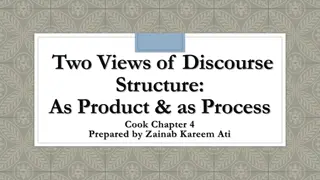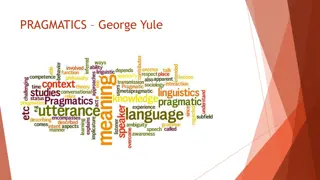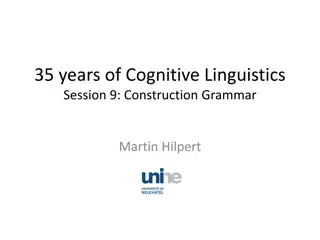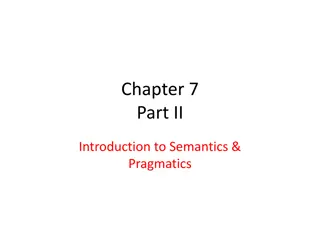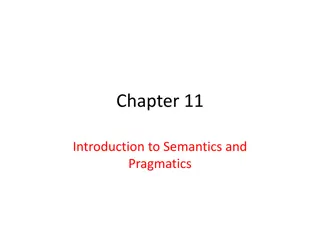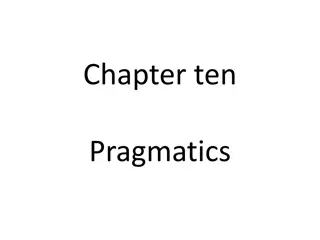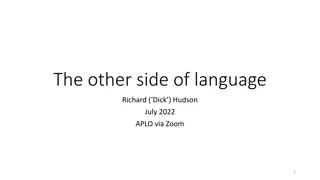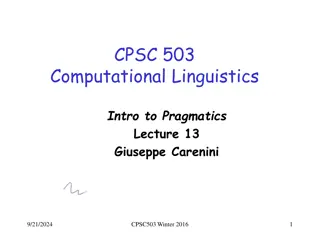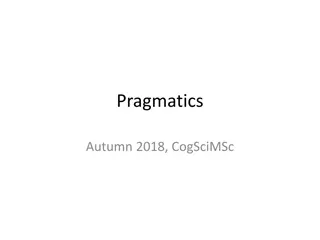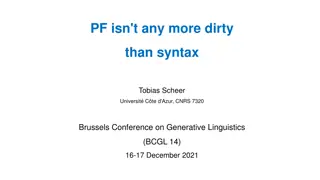Exploring Pragmatics in Linguistics Studies
Pragmatics delves into the study of implied meanings and how we interpret language in various contexts. It focuses on understanding communication beyond explicit words and explores the invisible meanings conveyed through situational and linguistic contexts. Deixis, physical context, and linguistic context play crucial roles in shaping our understanding of language nuances and interpretations.
Download Presentation

Please find below an Image/Link to download the presentation.
The content on the website is provided AS IS for your information and personal use only. It may not be sold, licensed, or shared on other websites without obtaining consent from the author. Download presentation by click this link. If you encounter any issues during the download, it is possible that the publisher has removed the file from their server.
E N D
Presentation Transcript
Pragmatics may mean The study of the speaker s meaning
"Pragmatics focuses on what is not explicitly stated and on how we interpret utterances in situational contexts. It is concerned not so much with the sense of what is said , that is, with what is communicated by the manner and style of an utterance."
The way we recognize or understand what is meant even it isn t actually said or written
Nancy: John , its the telephone. John : I m in the bath . Nancy : ok .
Linguistic context ( co-text): The set of other words used in the same phrase or sentence. The surrounding co-text has strong effect on what we think the word probably means .
The word bank - The river bank was soapy and steep. - She has to go to the bank withdraw some cash. to
Physical context The physical location influences our interpretation (the time and place in which we encounter linguistic expressions ).
refers to words and phrases that cannot be fully understood without additional contextual information. Words are deictic if their semantic meaning is fixed but their denotational meaning varies depending on time and/or place.
Some very common words in our language that can t be interpreted if we don t know the physical context of the speaker
Deixis expressions can be : 1. person deixis she, him , them , those , .. 2. spatial deixis her , there , near that , .. 3. temporal deixis now , then , last week , ..
Have a look at sentences : Do it now . I enjoy living in this city. Here is where we will place the statue. She was sitting over there.
An act by which a speaker use language to enable a listener to identify something . We can use proper , common nouns or pronouns .
"The man was holding the cat while the woman poured water on it." The word cat in the antecedent. The word it is anaphoric reference. Anaphora means referring back.
I turned the corner and almost stepped on it. There was a large snake in the middle of the path. The word it , is more explained about the snake ( cataphoric ).
A successful act of reference depends more on the listener s ability to recognize whet we mean than on the listener s knowledge of a word use.
An inference is additional information used by the listener to create a connection between what is said and what must be meant .
Examples : - Sally arrives at home at 4:30 and knows that her mother does not get off of work until 5. Sally also sees that the lights are off in their house. Sally can infer that her mother is not yet home.
- A child tries a new fruit and makes a disgusted face. His mother can infer that he does not like the taste of the fruit. - When the phone rang and Liz picked it up, she was all smiles. It can be inferred that she was pleased to receive the phone call.
We design our linguistic messages on the basis of assumptions about what our listeners already know . So, what a speaker assumes is true or known by a listener.
It is an implicit assumption about the world or background belief relating to an utterance whose truth is taken for granted
- Jane no longer writes fiction. Presupposition: Jane once wrote fiction. - Have you stopped eating meat? Presupposition: you had once eaten meat. - My car is a wreck. Presupposition: I have a car.
They are actions such as requesting , commanding , questioning or informing . So , language users perform actions by utterances.
Language users usually use certain syntactic structure to do certain functions as: Interrogative Question Imperative Command(request) Declarative Statement
When the syntactic structure(content) is identical with the function , the speech act is direct ,as in: - What s your name ? - Give me that book . - I have a pen . - Let me go .
When the syntactic structure is not identical (a question can be a request), the speech act is indirect, as in : - Can you pass the salt ? - Do you know the way to the garage? - You could be a little more quiet. - Why not stop here.
Indirect speech acts are used because they are more gentle and more polite in our society than direct speech acts. Compare : - Could you open that door for me ? - Open that door .
Politeness is best expressed as the practical application of good manners or etiquette. It has to do with ideas as being tactful , modest and nice .





